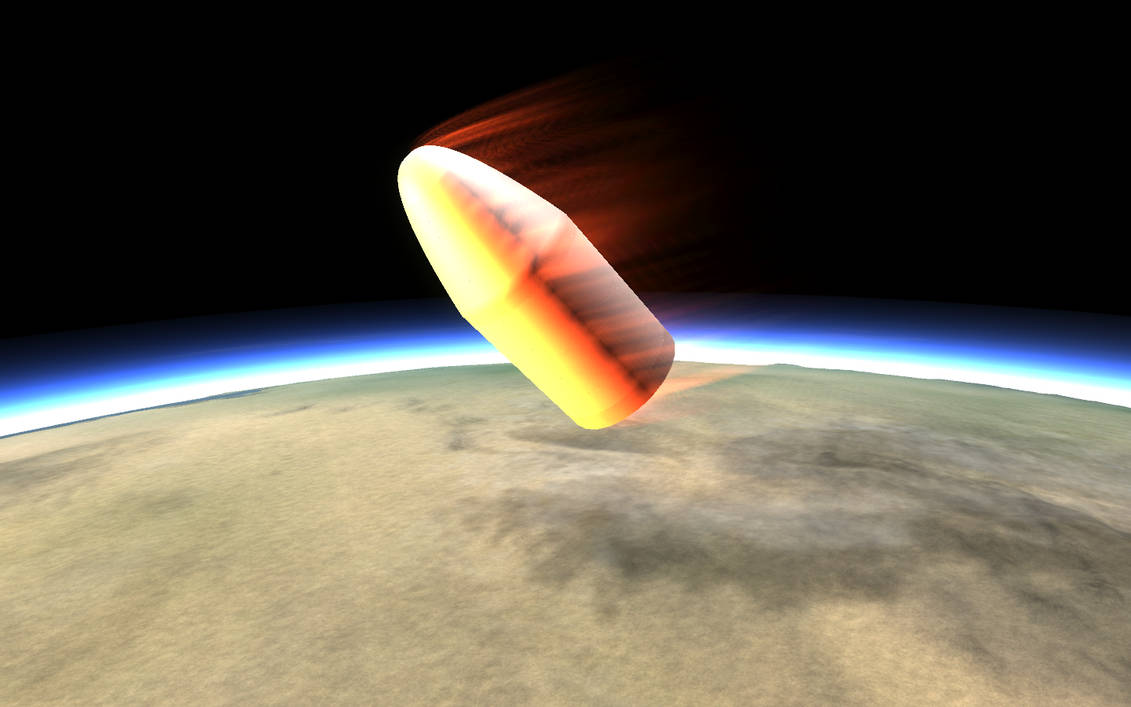Overview
If you forgot heatshield, this reentry mode can save your mission without cheats.
Contents table
Learned after many missions delayed because of my awful engineering skills that some missions can be saved if you have the fuel and pacience.
If you have experience jump to the section four.
1. Ballistic vs Aerodynamic entry.
2. Manouver nodes and navigation.
3. Requirements.
4. Brake manouver.

1. Ballistic vs Aerodynamic entry.
Ballistic entry is the most used by KSP players like me, it consists basically in aiming and shooting, at this point, if you forgot the heatshield you have the cheat options, spin cooled reentry or ctrl+alt+f12.


Theres videos on youtube about this basics, so i will keep it short….is all about angle, speed, drag and lift.
2. Manouver nodes and navigation.
We are going to use manouver nodes for two purposes, choose entry contact angle and altitude, you dont have to use, just understand the basics.
The manouver node is based on the orbit or flyby, the real references are the navball and altimeter.
Navball.

Altimeter
If you understand this basics jump to the next topic.
The manouver node consists of the three axis, and their counterparts adding to six nodes relative to the body you are orbiting.
Prograde serves to raise acceleration and apoapsis, retrograde serves reverse, apoapsis manouvers are parallel to the orbit, in the navball will be displayed as a target at the horizon sight.

Normal and antinormal serves to change the orbit angle, south and north, north is displayed as a brown line in the navball.

Radial in and radial out vectors are perpendicular to orbital plane horizon, the prograde vector, they change the position of apoapsis in the orbital plane horizon and are displayed as brown hemisphere or blue in the navball.


The navball displays all of this even if they dont have the manouver markers, for example at low circular equatorial orbit, you can start training this basics, prograde will display a horizon navball, radial out will point the craft to the sky or ground and normal manouver will be displayed perpendicullar to the navball equator, the north brown line.
3. Requirements.
For the realistic purposes the heatshield use is always required for reentry, but for ksp fun this manouver aims to minimize the heat on crafts without it, or trade for heat exchangers.
1. Engines.
2. Fuel.
3. Aerobraking.
4. Powerful Controls. (Reaction Wheels, RCS, Wings or Aerobrakes).

4. Brake manouver.
This Aerobraking Manouver requires the pilot to maintain as long as possible entry altitude and Attitude (angle), meaning understanding the navball and altimeter.
The navball has speeds relatives to orbit, surface and target, where using orbital speed.
The altimeter has two modes, sea level and terrain level, use sea level.
It has four sections in blue colors indicating how deep you are.
Black – space
Dark blue – Upper atm
Blue – Middle atm
Light blue – Lower atm
Our target is the first dark blue atmos, at Kerbin where is our pressure limitations.
Flyby from solar, interplanetary, munar or even low orbit, the target at kerbin periapsis is the outter dark blue atm layer for this manouver, in flyby attitude (angle) radial in / prograde (the nose of the craft down, engines up -45 degrees) at periapsis to cause speed / apoapsis decline, cicle and repeat at every periapsis pass.
After circularizing orbit, apoapsis will decrease until ship is at apoapsis, the desired speed is below 2300ms, so at your final aproach aim radial out / prograde (45 degrees nose up) to decrease speed.
At this point the craft will be able to perform reentry without heat shield, retract your solars because this still too fast and only engines, tanks, cabins, fairings, wings, control surfaces, structures will survive. Remember, if parts are blowing, speed is too high.


With a flyby inclination between prograde and radial in -45 degrees nose down angle you can lower your apoapsis / speed for less fuel expenses at circularization.

Attitude 45 degrees nose up to slow down without losing too much altitude, prograde / radial out.



